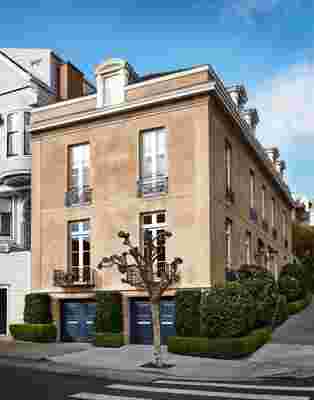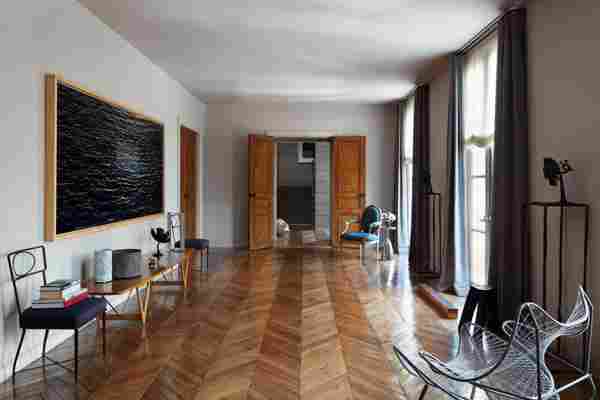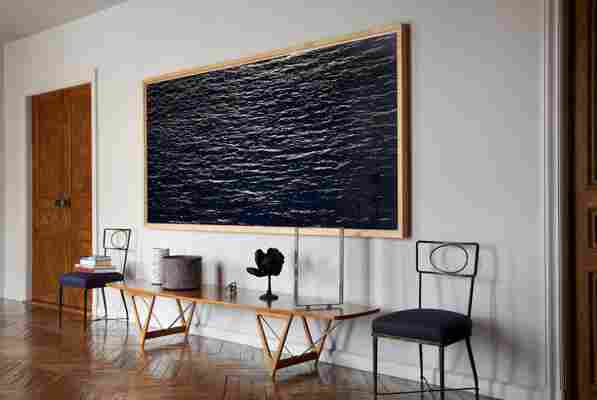First, in the spirit of full transparency, I should disclose that I worked on Steven Volpe’s ravishing new monograph, Steven Volpe: Rooms (Rizzoli), in which the AD100 designer’s own San Francisco house is featured prominently. Of all the luxurious estates and urban aeries presented in the volume, Volpe’s home is my favorite project: a kaleidoscopic self-portrait in three dimensions, expressing every aspect of the designer’s passions and priorities. All you need to know about Volpe, as a designer and a man, is written in the furnishings, books, artworks, and myriad architectural details he has orchestrated so masterfully.
The Beaux Arts house was built in 1912, after the great earthquake, as a single-family residence. Though the records are sketchy, the pioneering architect Julia Morgan, best known for her design of Hearst Castle in San Simeon, is said to have worked on the façade. At some point in the 1960s, the house was broken up into a warren of apartments. Howard Hein and Randolph Arczynski, founders of the venerable Randolph & Hein showroom, purchased the place in 1984 and converted it into two generous flats. The legendary San Francisco decorator Anthony Hail, one of Volpe’s mentors, occupied the lower apartment until his death in 2013. Volpe eventually had the good fortune of acquiring the entire house. The upper floors now serve as his residence, while the garden level accommodates a home office, gym, guest quarters, and gallery space.
The house is connected by a stairwell with walls covered in multiple layers of lime paint that simulate the effect of limestone blocks. The piano nobile is accessed through a capacious gallery, measuring roughly 25 feet long by 15 feet wide, with an 18th-century oak floor laid in a Hungarian point pattern. One end of the hall is anchored by an important 18th-century Georges Jacob chair, juxtaposed with an avant-garde 1950s Luciano Grassi chair of swirling filament at the opposite end. The gallery also incorporates a Carl Andre copper cube sculpture, chairs by Gilbert Poillerat, a Richard Misrach photograph, and a pair of 17th-century copies of bronze mounts from a classical Roman bowl. “The collection of things in this space demonstrates the elasticity of my interests, from the antique to the contemporary. It’s a testament to my love of great objects,” Volpe says of the heady brew.
The living room, much like the entry gallery, encompasses a group of artworks, furniture, and objects that each possess an intimate connection to Volpe’s life as a designer and collector. There are signature furnishings by Joaquim Tenreiro , Joseph-André Motte , Robert Mallet-Stevens, Wendell Castle , Ettore Sottsass , Martin Szekely , and Hun-Chung Lee, along with artworks by Sterling Ruby , Mel Bochner , Diego Giacometti , Ruth Asawa , Donald Judd , Jef Verheyen , and others. One of the designer’s most prized possessions is a 19th-century ceramic snake given to Tony Hail by the great Billy Baldwin , which Hail subsequently gifted to Volpe.



Practically every object in the house has a similarly personal, idiosyncratic backstory. There is a pair of mummified Egyptian ibises from the Ptolemaic era that once had pride of place on Hail’s mantel; a draped metal console by John Dickinson surmounted by a Hiroshi Sugimoto photograph in the office; a Peter Hujar image of David Wojnarowicz, and on and on. “Working on this house has been a process of endless refining, adding and subtracting elements based on what feels right at any given moment. The house is not a static thing. It continues to grow and evolve,” Volpe says.
Buy now for unlimited access and all of the benefits that only members get to experience.
The designer’s latest emendations focused on the garden level of the residence as well as the primary bedroom suite at the top. Spurred by the pandemic lockdown, he set up a workout area on the lower floor—what he calls his “COVID gym”—and set up the remaining rooms as a combination laboratory, office, and meeting space. “It’s a much less structured environment than the floors above. I wanted something that had more breathing room around it,” Volpe notes. In addition to tweaking the furnishings in his bedroom, the designer undertook a six-month gut renovation of the primary bath. “I’m bored with using a lot of stone, so I wanted to play with tile,” the designer says, describing the artisanal blue-and-white tiles that now form a graphic envelope for a custom vanity and a Water Monopoly tub with an old-school English vibe. “It’s a simple, honest bathroom that feels modern but old at the same time,” he adds.
Although the property encompasses a proper walled garden of trim boxwood and gurgling fountains, one might say that the entire house represents a hortus conclusus in its own right: a self-contained universe of beauty, rigor, imagination, and artistry. This is the world of Steven Volpe, the backdrop for a truly well-lived life.
